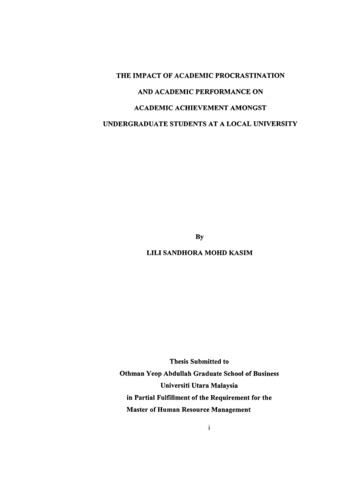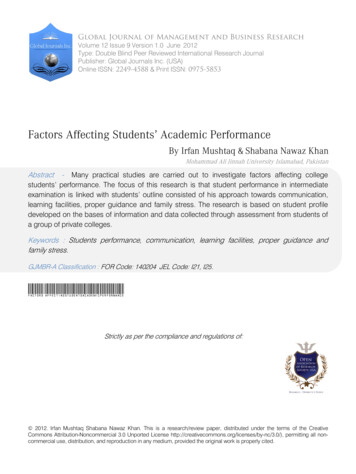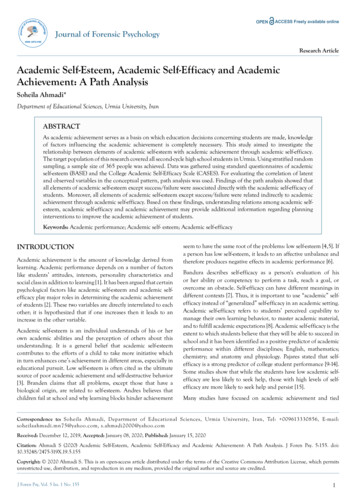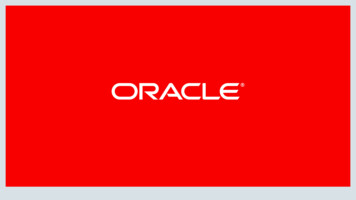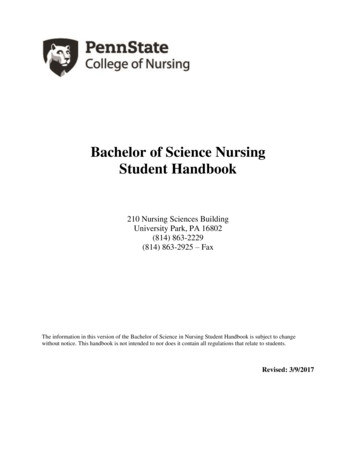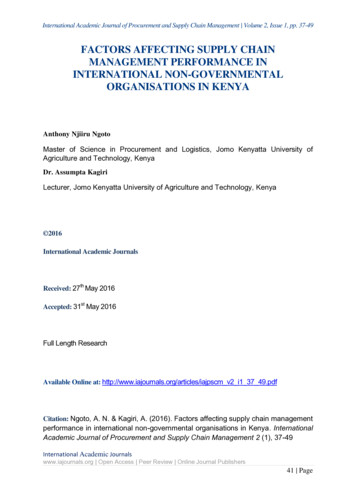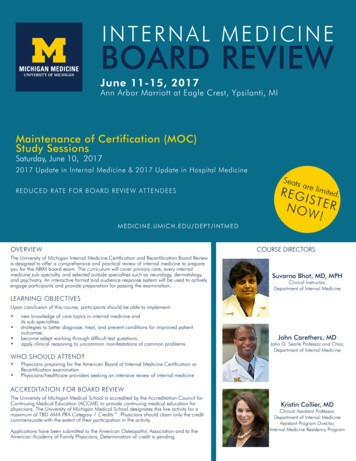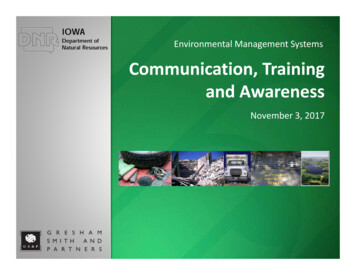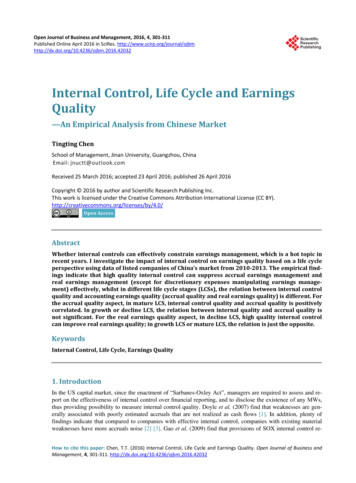
Transcription
Journal of Education and PracticeISSN 2222-1735 (Paper) ISSN 2222-288X (Online)Vol.6, No.14, 2015www.iiste.orgInternal Challenges Affecting Academic Performance ofStudent-Athletes in Ghanaian Public UniversitiesDaniel Apaak1*Emmanuel Osei Sarpong21.Sports Section, University of Cape Coast, Cape Coast, Ghana2.Department of Health, Physical Education, Recreation and Sports, University of Education, Winneba, Ghana* E-mail of the corresponding author: bavelim2002@yahoo.comAbstractThis paper examined internal challenges affecting academic performance of student-athletes in Ghanaian publicuniversities, using a descriptive survey research design. Proportionate random sampling technique wasemployed to select Three Hundred and Thirty-Two (332) respondents for the study. The instrument used ingathering data for the study was a questionnaire titled “Questionnaire on Internal Challenges AffectingUniversity Athletes (QICAUA)” structured and developed by researchers. The QICAUA was validated by twojurors in the field of physical education and sport, from Ghana and Nigeria and pilot tested using test-retestmethod. A reliability correlation coefficient of .85r was obtained from the reliability testing. In all, two researchhypotheses were formulated and tested at 0.05 alpha level of significance. Data collected were analyzed usingchi-square (x2) statistical method. The findings from the study showed that time constraints andphysical/emotional strain were significant internal challenges affecting the academic performance of studentathletes in Ghanaian public universities. Based on these findings, the study recommends that Management ofuniversities, university sports administrators and the Ghana Universities Sports Association (GUSA) shouldcollaborate to schedule sports programmes in such a way that student-athletes will have adequate time for bothacademics and sports; student-athletes should be counselled on how to manage their time effectively on campus;and coaches should ensure that student-athletes are not over worked physically and emotionally during trainingand competitions.Keywords: Academic Performance; Challenge; Public Universities; Student-Athlete.1. IntroductionA student-athlete is a participant in an organized competitive sport sponsored by an educational institution inwhich he or she is enrolled. Student-athletes must typically balance the roles of being full-time students and atthe same time being athletes (Gerdy, 2000). According to Cigliano (2006) participation in university sports, acommon human behaviour, is an activity that permeates our society educationally, financially, psychologically,and politically. Student-athletes are seen as a highly visible subgroup of students whose performance andvisibility can influence the formation of an institution’s image (Zimbalist, 1999). Manning (2012) argues that theterm student-athlete is the only term that employs a dash to explain a student’s role in an extracurricular activity.Manning went further to say that universities do not term students who participate in band activities as “studentmusicians” or in debate clubs as “student-politicians.” As such, student-athletes represent a clearly identifiableand unique population. In as much as student-athletes face many of the same challenges as non-athletes, theirdual roles can compound these challenges confronted by all university students.Howard-Hamilton and Watt (2001) categorized the challenges faced by student-athletes based on theirunique environmental demands and responsibilities into four components; that is, role conflict, role strain, valuealienation and exploitation. Manning (2012) listed depression, isolation, academic inferiority, substance abuse,injury, identity foreclosure, pregnancy, mental health disorders, learning disabilities, hazing, exploitation, andsport retirement as some of the challenges exacerbated by students’ participation in university sports. Simiyu(2010) on the other hand grouped student-athlete challenges into individual/personal and external challenges.Simiyu went further to mention personal involvement in academic oriented activities, time constraints, classattendance, personal goal setting and career choices, physical and emotional fatigue, transition to collegeenvironment and academic grades as individual/personal challenges, with the following as external challenges;coach demands, institutional policies, discrimination, marginalization from college mainstream activities, collegemission and learning environment, and eligibility demands.According to Kissinger and Miller (2009), student athletes generally face six distinctive challenges,these are, balancing athletic and academic responsibilities, balancing social activities with athleticresponsibilities, balancing athletic success and or failures with emotional stability, balancing physical health andinjury with the need to continue competing, balancing the demands of relationships with entities such as coaches,teammates, parents and friends, and addressing the termination of one's college athletic career. Göktaş (2005)mentioned the following as challenges student-athletes are faced with; learning to balance athletic and academicpursuits, adapting to a certain degree of isolation from social and more “mainstream” activities, managingsuccess or lack thereof, attending to their physical health in a more deliberate way as to avoid injury and18
Journal of Education and PracticeISSN 2222-1735 (Paper) ISSN 2222-288X (Online)Vol.6, No.14, 2015www.iiste.orgsubsequent rehabilitation, satisfying multiple relationships, terminating an athletic career, academic difficulties,role conflict, social and leisure challenges, separation anxiety due to athletic career retirement, substance abuseissues, and weight management/eating disorders. Internal or personal challenges are those challenges thatemanate from the student-athletes’ actions and/or inactions (Simiyu, 2010).2. Literature ReviewIn the literature on challenges facing university athletes, time constraints and physical/emotional strain appear tobe among the most reported (Gentsch, 2014; Feldpausch, 2011; Simiyu, 2010; Kissinger & Miller, 2009;Thomas, 2008; Morgan, 2005; Göktaş, 2005). On time, Göktaş (2005) opined that one of the most significantchallenges facing university athletes was the time needed to effectively combine their dual roles of beingstudents and athletes. Manning (2012) stated that student-athletes are unique compared to non-athletes becausewith the athletic demands required of them, they must devote a large amount of extra time to their athleticactivities in addition to regular class work and allocating enough time to fulfill personal social needs. Kissingerand Miller (2009) citing Etzel (1989), pointed out that successfully balancing the time demands required totackle all of the multiple activities unique to student-athletes often prove to be too much to handle and leavesathletes susceptible to mental and physical distress.Morgan (2005) in a study found out that, student-athletes repeatedly expressed the challenge towardsthe amount of time they had available for academic matters after fulfilling their athletic commitments.Feldpausch (2011) commented that even university athletes with an appropriate balance of academic and athleticmotivation have difficulty finding the necessary amount of time to succeed both in the class and on the field.Supporting this stance of time constraints being a serious challenge, McKenna and Dunstan-Lewis (2004)discovered from a study that time commitments and physical exhaustion were the most frequently reportedchallenges facing student-athletes in universities of the United Kingdom. A research by Aries, McCarthy,Salovery, and Banaji (2004) involving 521 students from an Ivy League university and 353 students from acollege revealed that student-athletes had significant difficulty in finding time to study and earn good grades.The researchers concluded that although in the end, most athletes in the study graduated with comparable gradesto non-athletes who had similar qualifications, the athletes reported a greater struggle to find time to study andachieve academically. In a case study involving African-American football players at a major college, Singer(2008) revealed that the interviewed African-American football players at that particular college struggled withtime demands as they put more time into football than they actually did in school.Humphrey, Yow and Bowden (2000) reported from a study that more than 40 percent of male athletesand well over fifty percent of female athletes complained of time as the most serious cause of their stress. Mostof the respondents in the study, according to the researchers, felt that there was simply not enough time for themto combine academics and sports and to do their best in both areas. This enabled the research team to concludethat time in particular was the most important challenge facing student-athletes. A study by Geiger (2013)revealed that the academic performance of student-athletes was negatively affected by time constraints resultingfrom demanding sports endeavours, among other things. Godfrey (2010) concluded that the challenge that seemsto hurt student-athletes the most academically was time constraints created through sports, making it difficult forathletes to devote time to study or earn good grades.Simiyu (2012) contends that the emotional and physical strain of sports competitions make studyingdifficult for student-athletes. Godfrey (2010) argues that time constraints places a heavy demand on the physicaland emotional aspects of the student athlete and with little down time for psychological and physical recovery,an athletes’ sport could wreak havoc on his/her ability to concentrate on studies. Thomas (2008) is of the viewthat whilst the physical strain of a student-athlete‘s season may be easy to conceptualize, the emotional strain isharder to quantify but is as prevalent. Geiger (2013) pointed out that in addition to the pressures of time, generalfatigue from training and competition could take a toll on a student-athlete both mentally and physically, whichcould negatively impact his/her academic performance. In a study, Feldpausch (2011) reported that in addition totime demands, student-athletes also complained of being physically and emotionally exhausted when ever theyhad to devote time to academics, lessening the quality of academic performance. Godfrey and Satterfield (2009)carried a qualitative study and concluded that student-athletes felt drained physically and emotionally afterpracticing their sports and were just too tired to focus on any academic work. According to Thomas (2008) thecumulative physical and emotional toll due to sports involvement throughout the academic year in the universitycould affect the student-athlete’s ability to concentrate on studies if care is not taken. Thomas concluded thatthese physical and emotional strains leave the student-athlete tired all the time which translates to failure to doassignments, dose off in class, miss class to recuperate in bed, poor concentration and mental lapses.Papanikolaou, Nikolaidis, Patsiaouras and Alexopoulos (2003) added that the psychological and physical toll ofthe sports of student-athletes leaves only a limited amount of energy to devote to academic experiences, andstudent-athletes also have only few hours of the day to invest in their coursework due to their sports obligations.Ghana, a developing country in West Africa, has a well-structured university sports system overseen by the19
Journal of Education and PracticeISSN 2222-1735 (Paper) ISSN 2222-288X (Online)Vol.6, No.14, 2015www.iiste.orgGhana Universities Sports Association (GUSA). As a paid-up member of both the International UniversitySports Federation (FISU) and the Federation of Africa University Sports (FASU), Ghana has been an activeparticipant in competitions organized by these two bodies for student-athletes (GUSA, 2013; GUSA, 2014).Internally, student-athletes in Ghana are very much engaged in sports competitions at various levels as onewould expect. Student-athletes in Ghana are equally challenged in combining their dual roles of being studentsand at the same time athletes. Although some studies have been conducted on challenges facing universitystudent-athletes in the developed world, particularly in places such as the United States of America, the UnitedKingdom, Canada etc, literature available shows that in a developing country like Ghana no such studiesconcerning student-athletes have been conducted. The purpose of this research therefore was to investigatewhether time constraints and physical/emotional strain were serious challenges affecting the academicperformance of student-athletes in Ghanaian public universities.3. MethodologyDescriptive survey research design was used for the study. The population comprised all 1,158 student-athletesfrom the 7 Ghanaian public universities that participated in the 2014 Ghana Universities Sports Association(GUSA) Games held at the University of Cape Coast. Three Hundred and Thirty-Two (332) respondents wereselected from all 7 public universities as the sample using proportionate random sampling technique. Theinstrument used in gathering data for the study was titled “Questionnaire on Internal Challenges AffectingUniversity Athletes (QICAUA)”. The QICAUA, which comprised 12 “Agree” or “Disagree” items, was adaptedfrom two instruments by Yelk, (2013) and Cigliano (2006). Items from the two questionnaires were re-frammedto suit the context of the current study. The instrument was validated by two jurors in the field of physicaleducation and sport, from Ghana and Nigeria. Test-retest method was used to determine the reliability of theinstrument. Reliability coefficient result obtained was .85 after pilot testing the instrument. Two researchhypotheses formulated, were tested using inferential statistics of chi-square (x2) at a .05 alpha level ofsignificance.4. Results and Discussion of FindingsHypothesis 1: Time constraint is not a significant challenge affecting academic performance of student-athletesin Ghanaian public universities.Table 1: Time Constraint as a Significant Challenge Affecting Academic Performance of Student-athletes inGhanaian Public UniversitiesS/N ItemADRowX2DF Critical RemarksTotalcalValue1.As an athlete, time spent on training for 231101332my sport affects my studies.(69.6) (30.4)As an athlete, time spent on travelling for 229sports competitions affects my preparation (69.0)for examinations.3As an athlete I miss a lot of Lectures, 229Quizzes and Class Assignments because of (69.0)the time spent during training andcompetitions.4As an athlete, my time management skills 214are poor.(64.5)5I have put a lot of time into playing my 170sport as an athlete than studying.(51.2)6I spend more time thinking about sport 168than anything else.(50.6)Column Total1,241x2 cal 57.48; critical value 11.07; df 5; p 49.4)75133257.482511.07Rejected3323321,992Results in Table 1 show a calculated chi-square value of 57.48 against a critical value of 11.07 withdegree of freedom of 5 at 0.05 alpha level of significance. Since the calculated chi-square value is greater thanthe critical value, the null hypothesis which stated that time constraint is not a significant challenge affectingstudent-athletes in Ghanaian public universities, is rejected. This means that time constraint is a seriouschallenge affecting the academic performance of student-athletes in Ghanaian public universities.20
Journal of Education and PracticeISSN 2222-1735 (Paper) ISSN 2222-288X (Online)Vol.6, No.14, 2015www.iiste.orgHypothesis 2: Physical/emotional strain is not a significant challenge affecting academic performance of studentathletes in Ghanaian public universities.Table 2: Physical/Emotional Strain as a Significant Challenge Affecting Academic Performance of Studentathletes in Ghanaian Public UniversitiesS/N ItemsADRowX2DF Critical RemarksTotalcalValue1.I get so tired after training that I sometimes 229103332miss lectures.(69.0) (31.0)I sleep during lectures because of tiredness 172and bodily pain sustained from training.(51.8)3I hardly contribute during lectures because 175of tiredness any time I train for my sports.(52.7)4I can hardly concentrate during lectures 168because of tiredness after training.(50.6)5I get emotional fatigued after competitions 172such that I can hardly study for some time.(51.8)6The stress and anxiety of travelling to and 178from competition affects my studies.(53.6)Column Total1,094x2 cal 32.47; critical value 11.07; df 5; p 9833233233232.472511.07Rejected3323321,992Results in Table 2 show a calculated chi-square value of 32.47 against a critical value of 11.07 withdegree of freedom of 5 at 0.05 alpha level of significance. Since the calculated chi-square value is greater thanthe critical value, the null hypothesis which stated that physical/emotional strain is not a significant challengeaffecting student-athletes in Ghanaian public universities, is rejected. This means that physical/emotional strainis a significant challenge affecting the academic performance of student-athletes in Ghanaian public universities.Null hypothesis 1, which stated that time constraint is not a significant challenge affecting studentathletes in Ghanaian public universities, was rejected, implying that time constraint is a serious challengeaffecting the academic performance of student-athletes in Ghanaian public universities. Majority of respondents(69.6%, 69.0%, 69.0%, 64.5%, 51.2%, 50.6%) agreed that time constraints was indeed a serious challengeconfronting them. Similar findings have been reported in studies by Singer (2008), Morgan (2005), McKennaand Dunstan-Lewis (2004), Aries, McCarthy, Salovery, and Banaji’s (2004), and Humphrey, Yow and Bowden(2000). The findings of this study also agree with the position taken by Geiger (2013) who revealed that theacademic performance of student-athletes was negatively affected by time constraints resulting from demandingsports endeavours and also that of Godfrey (2010) who concluded that the challenge that seemed to hurt studentathletes the most academically was time constraints created through sports, making it difficult for athletes todevote time to study or earn good grades. The opinion by Göktaş (2005) that one of the most significantchallenges facing university athletes was the time needed to effectively combine their dual roles of beingstudents and athletes sits well with the findings of this research.Null hypothesis 2, which stated that physical/emotional strain is not a significant challenge affectingstudent-athletes in Ghanaian public universities, was rejected, implying that physical/emotional strain is also asignificant challenge affecting the academic performance of student-athletes in Ghanaian public universities.Results also revealed that majority of the student-athletes (69.0%, 51.8%, 52.7%, 50.6%, 51.8%, 53.6%) were ofthe view that the physical/emotional strain of participating in sports was also a serious challenge affecting them.The findings of this study agree perfectly with Feldpausch (2011) who reported from a study that in addition totime demands, student-athletes also complained of being physically and emotionally exhausted when ever theyhad to devote time to academics, lessening the quality of academic performance. Godfrey and Satterfield (2009)also reported similar findings from their qualitative research, that student-athletes felt drained physically andemotionally after practicing their sports and were just too tired to focus on any academic work. Geiger’s (2013)comments that general fatigue from training and competition could take a toll on a student-athlete both mentallyand physically, and this could negatively impact his/her academic performance, Simiyu’s (2012) contention thatemotional and physical strain of sports competitions make studying difficult for student-athletes, and the positiontaken by Papanikolaou et al. (2003) that the psychological and physical toll of the sports of student-athletesleaves only a limited amount of energy to devote to academic experiences, are all in line with findings of thisstudy. Thomas (2008) concluded that the cumulative physical and emotional toll due to sports involvementthroughout the academic year in the university, which leaves the student-athlete tired all the time, can translate tothe following; failure to do assignments, dose off in class, miss class to recuperate in bed, poor concentration and21
Journal of Education and PracticeISSN 2222-1735 (Paper) ISSN 2222-288X (Online)Vol.6, No.14, 2015www.iiste.orgmental lapses. This conclusion mirrors the views of student-athletes in Ghanaian public universities on thephysical/emotional challenge facing them.It is important to point out that, university student-athletes across developed and developing countriesare all faced with the challenge of time in combining their dual roles of being students and athletes and also theyall suffer from the physical/emotional strain of participating in sports. These challenges have the potential ofseriously affecting the academic performance of the student-athletes if care is not taken. Secondly, the fact thatstudent-athletes may be performing well academically compared to non-athletes on university campuses does notmean that the athletes are not facing challenges. Aries et al. (2004) agree with this position in their conclusionfrom a study that although most athletes graduated with comparable grades to non-athletes who had similarqualifications in the end, athletes usually reported greater struggles to find time to study and achieveacademically.5. Conclusions and RecommendationsIt was concluded based on the findings of this study that time constraint and physical/emotional strain wereserious challenges affecting academic performance of student-athletes in Ghanaian public universities.Recommendations made include the following; that management of the various public universities, universitysports administrators and the Ghana Universities Sports Association (GUSA) should collaborate to schedulesports programmes within each academic year in such a way that student-athletes have adequate time to studyand make good grades and at the same time participate in their various sporting activities; university sportsadministrators should counsel student-athletes on how to manage time available to them on campus to ensurethat their academic work and sports pursuits do not suffer; and coaches in the public universities should alsoensure that student-athletes are not over worked during preparations for competitions or during competitions, sothat the athletes do not get physically and emotionally exhausted, since such tiredness can affect their academicperformance.ReferencesAmos, C. (2013). A Quantitative Analysis of Collegiate Athletic Involvement and Academic Achievement amongSport Management Students. A Master’s Thesis submitted to the School of Post-Graduate Studies, rs/288Aries, E., McCarthy, D., Salovey, P., & Banaji, M. R. (2004). A comparison of athletes and non-athletes athighly selective colleges: Academic performance and personal development. Research in Higher Education,45(6), 577-602.Byrd, C. E., & Ross, S. M. (1991). The influence of participation in junior high athletics on students' attitudesand grades. Physical Educator, 48(4), 170-177.Cigliano, L. M. (2006). A perceptual study of the impact of athletic programs in selected community colleges inthe State of Tennessee. Electronic Theses and Dissertations Paper 2184. Retrieved April 12, 2015, fromhttp://dc.etsu.edu/etd/2184Etzel. E. (1989). Life stress, locus-of-control and sport competition anxiety patterns of college student-athletes.Unpublished doctoral dissertation. West Virginia University, Morgantown.Feldpausch, B. M. (2011). An investigation of need for academic support programs for collegiate athletes. M. A.in Education Thesis submitted to Northern Michigan UniversityGeiger, N. M. (2013). Intercollegiate athletics in Canada and the United States: Differences in access, quality,and funding. College Quarterly, 16 (3).Gentsch, H. (2014). Student-Athlete or Athlete-Student?: A Comparative Study on the Effects of Role Identity,Time Constraints, and Motivation on Academic Success and Satisfaction with College life Experience.Unpublished M. A. Thesis submitted to the Graduate Faculty of Texas Tech University.Gerdy, J. R. (Ed.). (2000). Sports in School: The future of an Institution. New York, NY: Teachers College Press.Ghana Universities Sports Association (2013). A Report on Ghana’s Participation in 2013 FISU Games held inKazan, Russia. Cape Coast: GUSAGhana Universities Sports Association (2014). A Report on Ghana’s Participation in 2014 FASU Games held inNairobi, Kenya. KNUST, Kumasi: GUSAGodfrey, M. G. (2010). College football players: The new nontraditional student. Ph. D. Dissertation .edu/all dissertationsGodfrey, M.G., & Satterfield, J.W. (2009). The effects of athletic culture formation and perceived facultystereotypes in higher education. Manuscript submitted for publication AERA.Göktaş, Z. (2005). An investigation on the problems of college student-athletes participating in Universiade 2005.European Journal for Sport and Society, 7 (1), 53-68.22
Journal of Education and PracticeISSN 2222-1735 (Paper) ISSN 2222-288X (Online)Vol.6, No.14, 2015www.iiste.orgHoward-Hamilton, M.F. and Watt, S. (Eds.). (2001). Student services for athletes: New directions for studentservices. San Francisco, CA: Jossey-Bass Publishers.Humphrey, J. H., Yow, D. A. & Bowden, W. W. (2000). Stress in college athletics: Causes, consequences,coping. Binghamton, NY: The Haworth Half-Court Press.Papanikolaou, Z., Nikolaidis, D., Patsiaouras, A., & Alexopoulos, P. (2003). The freshman experience: /Vol5Iss4/Commentary.htmJolly, J. C. (2008). Raising the question # 9 is the student-athlete population unique? And why should we care?Communication Education, 57(1), 145-151.Kissinger, D. B., & Miller, M. T. (2009). College Student - Athletes. Charlotte, NC: Information Age PublishingInc.Manning, B. (2012). Are collegiate athletic departments doing enough to develop the psychological well beingof their student-athletes? A research paper submitted to the University of Northern Colorado. Retrieved April 20,2015, from 7066Morgan, D. (2005). An investigation of selected academic and nonacademic predictor variables of academicperformance of student–athletes at Louisiana State University. Unpublished Ph. D. Dissertation submitted to theGraduate Faculty of the Louisiana State University and Agricultural and Mechanical College.Parham, W. D. (1993). The intercollegiate athlete: A 1990s profile. The Counseling Psychologist, 21(3), 411-429.Singer, J. N. (2005). Understanding racism through the eyes of African American male student-athletes. RaceEthnicity and Education, 8, 365–386.Simiyu, N. W. W. (2010). Individual and institutional challenges facing student athletes on U.S. collegecampuses. Journal of Physical Education and Sports Management, 1(2): 16-24. Retrieved April 19, 2015, fromhttp://www.acadjourn.org/ jpesmSimiyu, N. W. W. (2012). Challenges of being a black student athlete on U.S. college campuses. Journal ofIssues in Intercollegiate Athletics, 5, 40-63. Retrieved April 17, 2015, from http://www.csri-jiia.orgThomas, E. (2008). A college perspective on academics and the student-athlete. Coach & Athletic Director,77 (8), 29-37.Yelk, T. (2013). Non-cognitive factors affecting student athlete academic performance. Unpublished M.Ed.Thesis submitted to the College of Education and Human Service Professions, University of Minnesota, Duluth.Zimbalist, A. (1999). Unpaid professionals commercialism and conflict in big-time college sports. Princeton, NJ:Princeton University Press.23
The IISTE is a pioneer in the Open-Access hosting service and academic event management.The aim of the firm is Accelerating Global Knowledge Sharing.More information about the firm can be found on the homepage:http://www.iiste.orgCALL FOR JOURNAL PAPERSThere are more than 30 peer-reviewed academic journals hosted under the hosting platform.Prospective authors of journals can find the submission instruction on the followingpage: http://www.iiste.org/journals/ All the journals articles are available online to thereaders all over the world without financial, legal, or technical barriers other than thoseinseparable from gaining access to the internet itself. Paper version of the journals is alsoavailable upon request of readers and authors.MORE RESOURCESBook publication information: http://www.iiste.org/book/Academic conference: es-call-for-paper/IISTE Knowledge Sharing PartnersEBSCO, Index Copernicus, Ulrich's Periodicals Directory, JournalTOCS, PKP OpenArchives Harvester, Bielefeld Academic Search Engine, Elektronische ZeitschriftenbibliothekEZB, Open J-Gate, OCLC WorldCat, Universe Digtial Library , NewJour, Google Scholar
1.Sports Section, University of Cape Coast, Cape Coast, Ghana 2.Department of Health, Physical Education, Recreation and Sports, University of Education, Winneba, Ghana * E-mail of the corresponding author: bavelim2002@yahoo.com Abstract This paper examined internal challenges affecting academic performance of student-athletes in Ghanaian public
